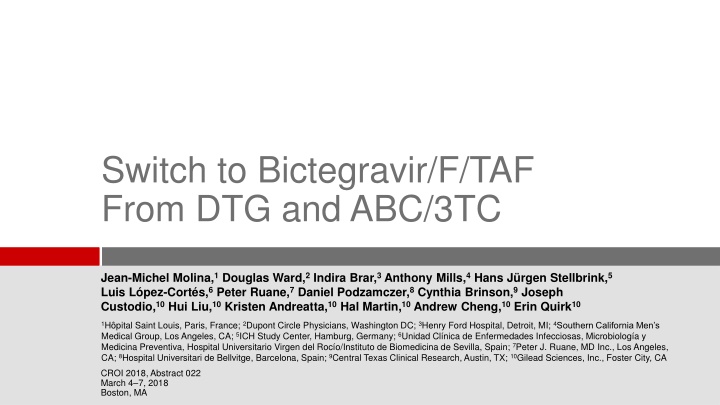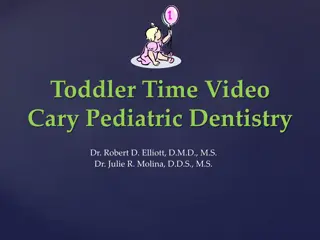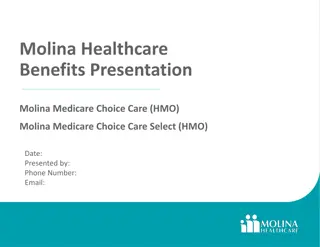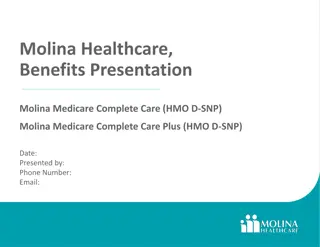
Bictegravir/F/TAF Switch Study: Efficacy and Safety Assessment
Learn about the study evaluating the efficacy and safety of switching from DTG/Abacavir/3TC to Bictegravir/F/TAF in HIV-suppressed adults. Bictegravir is a potent INSTI with low resistance potential, formulated as a single-tablet regimen. The study design and primary endpoints are outlined, highlighting noninferiority to existing regimens. Stay informed on the latest HIV treatment advancements.
Uploaded on | 1 Views
Download Presentation

Please find below an Image/Link to download the presentation.
The content on the website is provided AS IS for your information and personal use only. It may not be sold, licensed, or shared on other websites without obtaining consent from the author. If you encounter any issues during the download, it is possible that the publisher has removed the file from their server.
You are allowed to download the files provided on this website for personal or commercial use, subject to the condition that they are used lawfully. All files are the property of their respective owners.
The content on the website is provided AS IS for your information and personal use only. It may not be sold, licensed, or shared on other websites without obtaining consent from the author.
E N D
Presentation Transcript
Switch to Bictegravir/F/TAF From DTG and ABC/3TC Jean-Michel Molina,1Douglas Ward,2Indira Brar,3Anthony Mills,4Hans J rgen Stellbrink,5 Luis L pez-Cort s,6Peter Ruane,7Daniel Podzamczer,8Cynthia Brinson,9Joseph Custodio,10Hui Liu,10Kristen Andreatta,10Hal Martin,10Andrew Cheng,10Erin Quirk10 1H pital Saint Louis, Paris, France; 2Dupont Circle Physicians, Washington DC; 3Henry Ford Hospital, Detroit, MI; 4Southern California Men s Medical Group, Los Angeles, CA; 5ICH Study Center, Hamburg, Germany; 6Unidad Cl nica de Enfermedades Infecciosas, Microbiolog a y Medicina Preventiva, Hospital Universitario Virgen del Roc o/Instituto de Biomedicina de Sevilla, Spain; 7Peter J. Ruane, MD Inc., Los Angeles, CA; 8Hospital Universitari de Bellvitge, Barcelona, Spain; 9Central Texas Clinical Research, Austin, TX; 10Gilead Sciences, Inc., Foster City, CA CROI 2018, Abstract 022 March 4 7, 2018 Boston, MA
Introduction Bictegravir (BIC, B) is a novel, unboosted, potent INSTI with a high in vitro barrier to resistance and low potential for drug-drug interactions1,2 Co-formulated with emtricitabine and tenofovir alafenamide as a single-tablet regimen (B/F/TAF) Dosed once-daily with or without food In three large phase 3 trials, B/F/TAF was noninferior to: dolutegravir (DTG)-containing regimens in treatment naive patients3,4 boosted ATV or DRV-containing regimens in virologically suppressed patients5 No treatment emergent viral resistance to B/F/TAF was identified through Week 48 We assessed the efficacy and safety of switching from DTG/Abacavir/3TC (DTG/ABC/3TC) to B/F/TAF 1. Gallant JE, et al. J Acquir Immune Defic Syndr 2017;75:61-6; 2. Tsiang M, et al. Antimicrob Agents Chemother 2016.60:7086-97; 3. Gallant J, et al Lancet 2017; 4. Sax PE, et al. Lancet 2017. 5. Daar, ID Week 2017, Abstract 67504. 2
Study 380-1844: Design Primary Endpoint Week 0 48 B/F/TAF 50/200/25 mg qd HIV-suppressed adults on regimen containing DTG, ABC & 3TC* n=282 OLE B/F/TAF DTG/ABC/3TC placebo qd HIV-1 RNA <50 copies/mL for 3 mo eGFRCG 50 mL/min No active HBV infection No known resistance to study drugs 1:1 DTG/ABC/3TC 50/600/300 mg qd OLE B/F/TAF n=281 B/F/TAF Placebo qd Phase 3, randomized, double-blind, multicenter, active-controlled study (NCT02603120): North America, Europe, Australia Primary endpoint: proportion with HIV-1 RNA 50 copies/mL at Week 48 Noninferiority margin of 4% based on FDA snapshot algorithm *Could be components of single-tablet regimen. OLE, open label extension. 3
Baseline Characteristics Study 380-1844 B/F/TAF n=282 DTG/ABC/3TC n=281 Median age, years (range) 47 (21-71) 45 (20-70) Male, % 88 90 Race, % White 73 73 Black or African descent 21 22 Hispanic/Latino Ethnicity, % 16 19 Median CD4 cell count, cells/ L (IQR) 732 (554,936) 661 (478,874) Median eGFRCG, mL/min (IQR) 101(84,119) 101(85,122)
Virologic Outcome at Week 48 Study 380-1844 Treatment Difference in RNA 50, % (95.002% CI) Virologic Outcome p=0.59 95.0 93.6 100 Favors B/F/TAF Favors DTG/ABC/3TC B/F/TAF (n=282) DTG/ABC/3TC (n=281) 80 Patients, % 60 0.7 40 -1.0 2.8 p=0.62 20 5.3 4.6 1.1 0.4 0 -4% 0 4% HIV-1 RNA 50 c/mL 3 282 HIV-1 RNA <50 c/mL 264 282 No Virologic Data 15 282 267 281 1 281 13 281 Switching to B/F/TAF was noninferior to remaining on DTG/ABC/3TC 5
Virologic Outcome at Week 48 Study 380-1844 Treatment Difference in RNA 50, % (95.002% CI) Virologic Outcome p=0.59 95.0 93.6 100 Favors B/F/TAF Favors DTG/ABC/3TC B/F/TAF (n=282) DTG/ABC/3TC (n=281) 80 Patients, % 60 0.7 40 -1.0 2.8 p=0.62 20 5.3 4.6 1.1 0.4 0 -4% 0 4% HIV-1 RNA 50 c/mL 3 282 HIV-1 RNA <50 c/mL 264 282 No Virologic Data 15 282 267 281 1 281 13 281 Switching to B/F/TAF was noninferior to remaining on DTG/ABC/3TC No participant developed treatment-emergent resistance 6
Adverse Events Leading to Study Drug Discontinuation Study 380-1844 B/F/TAF n=282 6 (2) 2 1 1 1 1 0 DTG/ABC/3TC n=281 2 (1) 1 0 0 0 0 1 Patients, n (%) Overall Headache Vomiting Cerebrovascular accident Abnormal dreams Suicidal ideation* Pruritis *Not considered related to study treatment by investigator. 2 deaths occurred in the B/F/TAF arm, unrelated to study medication: Male, 71 years old: sudden death, atherosclerotic CVD on autopsy Female, 46 years old: alcohol and opioid toxicity 7
Most Common Adverse Events Through Week 48 Study 380-1844 B/F/TAF n=282 DTG/ABC/3TC n=281 Patients, n (%) Any AE (all grades) 225 (79.8) 225 (80.1) AEs occurring in 5% of patients Upper respiratory tract infection 29 (10) 27 (10) Nasopharyngitis 20 (7) 22 (8) Headache 19 (7) 21 (7) Diarrhea 24 (9) 14 (5) Arthralgia 19 (7) 10 (4) Insomnia 8 (3) 14 (5) 8
Study Drug-Related AEs Through Week 48 Study 380-1844 B/F/TAF n=282 DTG/ABC/3TC n=281 All Grades p-Value Any study drug-related AE, n (%) 23 (8) 44 (16) 0.01 Study drug-related AE in 1%, n (%) Headache 7 (3) 8 (3) Abnormal dreams 1 (<1) 5 (2) Flatulence 0 5 (2) Nausea 0 5 (2) Diarrhea 2 (<1) 4 (1) Fatigue 1 (<1) 3 (1) Insomnia 0 3 (1) p-value from Fisher exact test 9
Laboratory Abnormalities Through Week 48 Study 380-1844 B/F/TAF n=282 DTG/ABC/3TC n=281 Grade 3 or 4 Lab Abnormalities, n (%) Any 47 (17) 32 (11) in 2% of patients LDL elevation 14 (5) 13 (5) Increased amylase 7 (2) 0 ALT elevation 6 (2) 0 CK elevation 6 (2) 6 (2) Fasting hyperglycemia 6 (2) 2 (<1) No cases of rhabdomyolysis All amylase elevations were transient and not associated with pancreatitis; 4/7 cases had normal lipase Grade 3 and 4 ALT abnormalities were not study treatment related, did not result in study drug interruption, and were associated with other AEs: acute HCV infection (n=3), acute HAV infection (n=1), alcohol abuse (n=1), and NASH (n=1) 10
Change in eGFRCG Over Time Study 380-1844 B /F /T A F B/F/TAF A B C /D T G /3 T C DTG/ABC/3TC 2 0 Median Change From Baseline eGFRCG, 1 0 mL/min (Q1, Q3) 1.0 mL/min p <0.001* 0 -1.8 mL/min - 1 0 - 2 0 0 4 8 1 2 2 4 3 6 4 8 Week No discontinuations due to renal AEs and no cases of renal tubulopathy in either arm *From 2-sided Wilcoxon rank-sum test. 11
Changes in Quantitative Proteinuria at Week 48 Study 380-1844 Retinol-Binding Protein:Creatinine p=0.31* Albumin:Creatinine 2-microglobulin:Creatinine p=0.53* p=0.74* Median % Change From Baseline (Q1, Q3) 96 B/F/TAF 100 84 DTG/ABC/3TC 75 72 66 75 63 50 29 21 20 17 25 14 9 0 -6 -7 -25 -19 -20 -22 -34 -50 Baseline 5.6 mg/g 5.4 mg/g 99 g/g 96 g/g 75 g/g 77 g/g *From 2-sided Wilcoxon rank-sum test for % change from baseline at Week 48 for each marker for treatment comparison. 12
Changes in Spine and Hip BMD Through Week 48 Study 380-1844 Spine Hip 2 2 From Baseline (95% CI) 1 1 0.69 Mean % Change p=0.33* 0.30 0.16 p=0.47* 0.42 0 0 -1 -1 -2 -2 0 24 48 0 24 48 Week Week B/F/TAF n=256 DTG/ABC/3TC n=262 244 253 233 244 256 265 246 253 229 242 *From ANOVA model for comparison of B/F/TAF vs DTG/ABC/3TC at Week 48. 13
Fasting Lipid Changes at Week 48 Study 380-1844 Triglycerides Total LDL HDL Total Cholesterol p=0.77 Cholesterol p=0.42 Cholesterol p=0.13 Cholesterol:HDL p=0.56 3 0 Median Change From Baseline, mg/dL* p=0.028 2 5 2 0 1 5 B/F/TAF DTG/ABC/3TC 1 0 3 2 2 5 1 0 0 0 0 0 -1 -5 -5 -1 0 113 118 49 48 111 111 3.7 3.8 Baseline mg/dL 182 186 *p-values from 2-sided Wilcoxon rank-sum test. 14
Study 380-1844 Conclusions Switching to B/F/TAF was non-inferior to remaining on DTG/ABC/3TC No treatment emergent resistance was observed in either arm B/F/TAF was well tolerated Adverse events were comparable between arms at Week 48 The lipid, bone and renal safety profiles of switching to B/F/TAF were comparable to remaining on DTG/ABC/3TC through 48 weeks of treatment B/F/TAF offers an effective and safe alternative to DTG/ABC/3TC Study 380-1961: Switching to B/F/TAF in women (Kityo et al. Poster 500) 15
Acknowledgements We extend our thanks to: The participants, their families, and all participating study investigators and staff: AUSTRALIA: D Baker, M Bloch, D Smith BELGIUM: L. Vandekerckhove CANADA: L Charest, J de Wet, K Kasper, RP LeBlanc, B LeBouche FRANCE: J-M Molina, G Pialoux, P Pugliese, F Raffi GERMANY: K Arast h, A Baumgarten, M Bickel, J Bogner, S Esser, H J ger, J Rockstroh, H-S Stellbrink ITALY: A Antinori SPAIN: A Antela, B Clotet Sala, M Gutierrez, LF Lopez-Cortes, MJ P rez, D Podzamczer, A Rivero Roman UNITED KINGDOM: AE Clark, MA Johnson, J Ross, G Schembri, AP Ustianowski UNITED STATES: H Albrecht, J Bartczak, P Benson, D Berger, M Berhe, I Brar, C Brinson, JH Burack, BP Cook, D Coulston, C Creticos, GE Crofoot Jr, FA Cruickshank, E DeJesus, C Dietz, MP Dube, H Edelstein, C Fichtenbaum, J Flamm, JE Gallant, JC Gathe Jr, R Grossberg, DP Hagins, WK Henry, RK Hsu, M Johnson, CA Kinder, D Klein, A LaMarca, K Lichtenstein, N Lin, CT Martorelli, A Mills, JO Morales Ramirez, K Mounzer, CL Newman, G Oguchi, O Osiyemi, C Parspns, P Peyrani, G Pierone Jr, DJ Prelutsky, M Ramgopal, B Rashbaum, GJ Richmond, PJ Ruane, L Santiago, AJ Scarsella, SR Schrader, A Scribner, P Shalit, C Shikuma, ASO Shon, J Slim, J Stephens, WJ Towner, TJ Vanig, BH Wade, MB Wohlfeiler, AK Wurapa, BG Yangco. This study was funded by Gilead Sciences, Inc. 16




